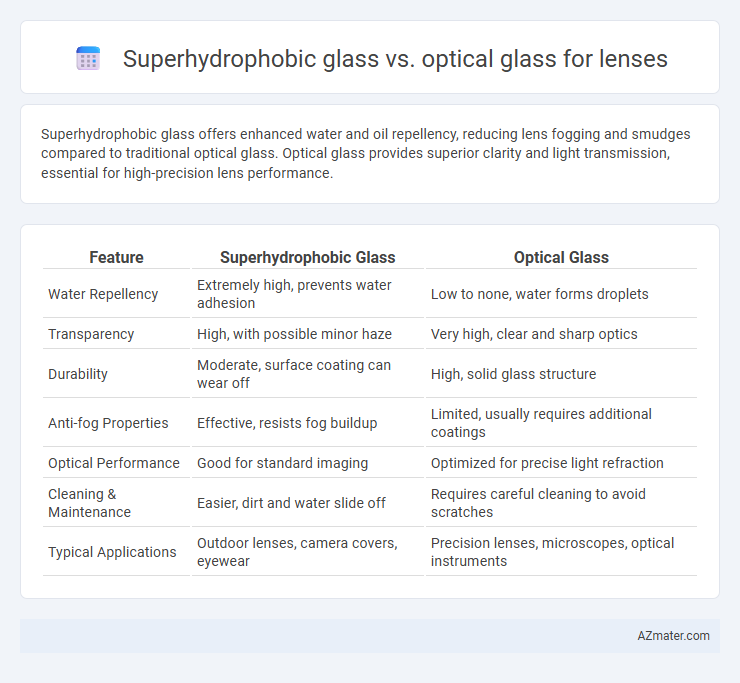Superhydrophobic glass offers enhanced water and oil repellency, reducing lens fogging and smudges compared to traditional optical glass. Optical glass provides superior clarity and light transmission, essential for high-precision lens performance.
Table of Comparison
| Feature | Superhydrophobic Glass | Optical Glass |
|---|---|---|
| Water Repellency | Extremely high, prevents water adhesion | Low to none, water forms droplets |
| Transparency | High, with possible minor haze | Very high, clear and sharp optics |
| Durability | Moderate, surface coating can wear off | High, solid glass structure |
| Anti-fog Properties | Effective, resists fog buildup | Limited, usually requires additional coatings |
| Optical Performance | Good for standard imaging | Optimized for precise light refraction |
| Cleaning & Maintenance | Easier, dirt and water slide off | Requires careful cleaning to avoid scratches |
| Typical Applications | Outdoor lenses, camera covers, eyewear | Precision lenses, microscopes, optical instruments |
Introduction to Lens Materials: Superhydrophobic vs Optical Glass
Superhydrophobic glass features an ultra-water-repellent coating that significantly reduces surface contamination and enhances optical clarity under wet or dirty conditions, making it ideal for lenses exposed to harsh environments. Optical glass, formulated with precise refractive indices and minimal dispersion, provides superior image quality and light transmission essential for high-precision lenses in cameras, microscopes, and eyeglasses. Comparing these materials highlights the trade-off between environmental durability in superhydrophobic coatings and the intrinsic optical performance of conventional optical glass.
Defining Superhydrophobic Glass: Properties and Applications
Superhydrophobic glass features a nanostructured surface that exhibits extreme water repellency with contact angles exceeding 150 degrees, significantly reducing water adhesion and fogging. This unique property enhances lens clarity and durability by preventing moisture accumulation and facilitating self-cleaning functions in optical devices. Compared to traditional optical glass, superhydrophobic glass improves visual performance and longevity in cameras, eyewear, and outdoor optical equipment.
Defining Optical Glass: Characteristics and Uses
Optical glass is a specially formulated material designed to transmit and refract light with minimal distortion, characterized by its high clarity, precise refractive index, and low dispersion, making it essential for lenses in cameras, microscopes, and eyeglasses. Superhydrophobic glass enhances traditional optical glass by incorporating a nano-structured coating that repels water and contaminants, improving durability and lens cleanliness without sacrificing optical performance. The superior water-repellent properties of superhydrophobic glass reduce maintenance requirements and improve visibility in adverse conditions, making it ideal for outdoor optical applications.
Water Repellency: Performance Comparison
Superhydrophobic glass exhibits superior water repellency compared to standard optical glass, achieving contact angles greater than 150deg, which causes water droplets to bead and roll off quickly, minimizing water adhesion and improving visibility in wet conditions. Optical glass, lacking this specialized coating, typically has contact angles around 40-70deg, leading to water accumulation that can distort images and reduce lens clarity. This enhanced water repellency of superhydrophobic glass ensures better performance for lenses in environments with frequent moisture exposure, such as camera lenses, automotive optics, and wearable devices.
Optical Clarity and Transmission Efficiency
Superhydrophobic glass exhibits enhanced water and dirt repellency, reducing surface contamination and maintaining optical clarity over time, which is crucial for lens performance. Optical glass is engineered for high transmission efficiency with minimal light scattering and absorption, ensuring precise image quality. The combination of superhydrophobic coatings on optical glass lenses optimizes both optical clarity and transmission efficiency by preserving a clean, clear surface while maintaining the glass's inherent optical properties.
Durability and Scratch Resistance
Superhydrophobic glass offers superior durability and scratch resistance compared to standard optical glass, thanks to its advanced nano-coating that repels water, dust, and oils, reducing surface wear and abrasion. Optical glass, while providing excellent clarity and light transmission, typically lacks this protective hydrophobic layer, making it more susceptible to scratches and environmental damage over time. The enhanced hardness and self-cleaning properties of superhydrophobic glass significantly extend lens lifespan in demanding conditions.
Maintenance and Cleaning Requirements
Superhydrophobic glass significantly reduces maintenance and cleaning requirements for lenses due to its water-repellent and self-cleaning properties, preventing dirt and smudges from adhering to the surface. Optical glass, while offering superior clarity and precision, tends to accumulate oils, dust, and fingerprints more readily, necessitating more frequent and careful cleaning with specialized solutions and tools. Choosing superhydrophobic coatings on optical glass lenses enhances durability and lowers the risk of scratching during maintenance, making it ideal for environments with high exposure to moisture and contaminants.
Impact on Image Quality and Performance
Superhydrophobic glass enhances lens performance by repelling water, oil, and dust, thereby maintaining clearer optical surfaces and reducing image distortion in wet or dirty environments. Optical glass, designed primarily for precise light transmission and minimal aberrations, ensures high image clarity and sharpness but can degrade in performance when contaminated by moisture or particles. Combining superhydrophobic coatings with high-quality optical glass significantly improves durability and consistent image quality, especially in challenging outdoor or humid conditions.
Cost and Availability: Which is More Economical?
Superhydrophobic glass for lenses typically incurs higher costs due to specialized coatings and advanced manufacturing processes, limiting its availability compared to conventional optical glass. Optical glass remains more economical and widely accessible, benefiting from established production techniques and extensive supply chains. For applications prioritizing budget and mass availability, optical glass offers a cost-effective solution without compromising fundamental optical performance.
Choosing the Right Lens Material for Your Needs
Superhydrophobic glass offers superior water repellency and anti-fogging properties, making it ideal for outdoor and high-moisture environments, enhancing lens durability and clarity. Optical glass excels in precise light refraction and minimal distortion, providing high image quality essential for photography and scientific applications. Selecting the right lens material depends on whether water resistance or optical performance is the priority for your specific needs.

Infographic: Superhydrophobic glass vs Optical glass for Lens
 azmater.com
azmater.com